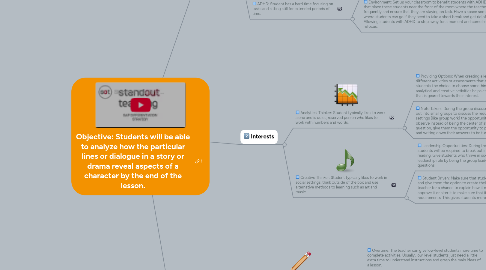
1. Profiles
1.1. ESL Learner: Student speaks English as a second language and may not be comfortable using it in an academic or social setting because they lack key vocabulary.
1.1.1. Vocabulary (21st Century Technology): Reading long passages from texts such as novels can be extremely tough and frustrating for ESL learners. The teacher can help by allowing the student to use a handheld device such as an iPad with a translation app to help with vocabulary that the student may not know yet.
1.1.2. Group Work: Allowing ESL learners to work in a group context with native speakers is a good strategy that allows the student to learn from (and with) other students. ESL students are more likely to model language displayed by their peers and this also allows students to answer questions that the ESL student may have and gives the teacher more time to spend elsewhere in the classroom.
1.2. ADHD: Student has a hard time focusing on tasks and sitting still for extended periods of time.
1.2.1. Instruction: The teacher can provide clear and simple instructions, both verbally and written, by posting them at the front of the class and reading them out loud. Important rules should be highlighted to help students with short attention spans who may not have the patience to read all of the instructions thoroughly. Repeating and checking for understanding is also a good strategy that will not only help ADHD students, but all students in the classroom.
1.2.2. Environment: Set up your classroom to benefit students with ADHD. Create seating arrangements that place these students near the front of the room where the teacher can check in on them more frequently and ensure that they are staying on task. Have a space somewhere in the classroom where students can go if they need to take a short break and get rid of some excess energy. Allowing students with ADHD to step away for a moment and come back actually allows them to refocus.
2. Interests
2.1. Analytical Thinker: Student typically likes to work alone and is quiet, reserved person who likes to work with numbers and words.
2.1.1. Providing Options: When creating a lesson plan, give students options as far as different activities or assessments that all meet the same objective. This will give students the choice to choose something that interest them. Providing both analytical and creative activities helps ensure that students can find something that is geared towards their interest.
2.1.2. Note Takers: During the group discussion portion of the lesson, students will be required to break out into small groups to discuss the required reading. Give students who don't do well in social settings (like group work) the opportunity to take notes for the group so they can sit back and observe instead of being the center of attention. Or, if working in a group altogether is out of the question, give them the opportunity to participate in the discussion questions by working alone and writing down their answers to be turned into the teacher.
2.2. Creative Thinker: Student typically likes to work in social settings, think outside of the box and use alternative methods to learning such as art and music.
2.2.1. Leadership Opportunities: During the group discussion portion of the lesson, students will be required to break out into small groups to discuss the required reading. Give students who thrive in social settings the opportunity to take on a leadership role by being the group leader and facilitating the discussion with questions.
2.2.2. Student Driven: Make sure that students know the anticipated learning outcome and give them the option to create their own activities. They can meet with the teacher for a chance to explain how it meets the objective and the teacher can approve it or alter it to make sure that it does in fact meet all of the requirements. This gives students more control over their learning.
3. Readiness Levels
3.1. Low-Level Performer: Student has a more difficult time keeping up with the class workload than their peers and takes longer to understand content.
3.1.1. Overtime: The teacher can give low-level students more time to complete activities. Usually, low-level students just need a little extra time to understand instructions and grasp the main ideas of a lesson.
3.1.2. Extra Help: Give low-level students the opportunity to come in after school and ask questions or seek extra help from the teacher. Encouraging students to do so will help them get up to speed with their peers. This will also allow them to have their work checked and evaluated before it is turned in for a grade.
3.2. High-Level Performer: Student has no difficulty keeping up with the class workload and and understands content quicker than their peers.
3.2.1. Extra Content: While low-level students may need extra time to complete tasks, high-level students won't typically need it. During the extra time that the low-level students need, the teacher can prepare an extra activity that the high-level students can work on during this time. For example, when creating the character Facebook profiles, high-level students can go to the library and use the computers to create a real profile instead of using the template provided.
3.2.2. Mentors: Give high-level students the opportunity to be a mentor to low-level students by helping them with homework or class activities. This gives the high-level student the chance to use their skills and also takes away some of the burden presented to the teacher. This is also a great way for students to build positive relationships with each other.
